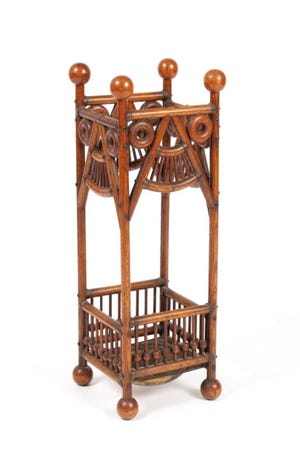
Arts and Crafts household furniture was in style from the late 19th to the early 20th century. It was really different from the ornate models of the previously Victorian era. It experienced the edge of new applications and mass creation. The Arts and Crafts movement promoted competent craftsmanship, high quality get the job done and very simple, strong styles.
Iconic Arts and Crafts and Mission workshops, like Stickley and Roycroft, are recognised for their uncomplicated home furniture built in dim oak with minimal ornamentation. This would not necessarily mean that just about every Arts and Crafts piece is a basic, heavy box!
This umbrella stand, which offered for $300 at a Selkirk auction in St. Louis has a mild, intricate glimpse. Even so, its design takes advantage of straight traces and very simple geometric designs. Its ball feet build a strong seem and, as an umbrella stand, it was made with use in mind.
Problem: I found an old electrical toaster from the 1920s at a flea current market. I am using it as a decoration in my kitchen area. What is the heritage of toasters?
Solution: Toasting bread with electrical power and not more than a fire was made feasible in 1905, when American metallurgist Albert L. Marsh developed a nickel-chromium alloy he termed “Chromel.”
It was lower in electrical conductivity, infusible and resistant to oxidation, which produced it the perfect metal to condition into filament wires and coils for heating features.
In 1908, Typical Electric powered patented its own nickel-chromium alloy that contained iron. It was identified as “calorite.” In 1909, GE released its D-12 bread toaster, invented by Frank Shailor, which was a commercial accomplishment, 19 many years ahead of the invention of bread-slicing devices in 1928. More than the next 100 many years, toasters were manufactured of metallic, wooden, porcelain and Bakelite.
The price of a vintage toaster depends on its rarity, aesthetics and the design of its electrical and mechanical functions. We are amused by a toaster two times as very long as other folks that toasts the bread by sending it by the long toaster rather of popping up.
Q: My favourite doll increasing up was Tearie Dearie. I keep in mind playing with her for hours and staying stunned that she could “drink” h2o from a bottle, and then in fact cry and wet a diaper. Are dolls like this collectible?
A: Many dolls from the 1960s and 1970s are collectible purely for sentimental reasons. Tearie Dearie is one. She was manufactured by Great Toy Co. (in company 1907-1997) starting up in 1964.
She was 9-inches tall and was created of vinyl. She came in a pink plastic crib that also served as her tub. The doll and scenario marketed for $2.88. A set of a few outfits was $4.97, and the doll, situation and outfits were bought together for $7.77. Relying on issue and add-ons, she now sells for about $25. There is certainly nothing at all improper with collecting for sentimental good reasons.
Q: I have a Regulator wall clock with Roman numerals that utilizes “IIII” instead of “IV” for the range 4. Is that uncommon? Does it make the clock much more useful?
A: The Roman numeral “IIII” is prevalent in clocks designed before 1850. Later, manufacturers at times use the numeral to imitate older styles. Age is just a single attribute of a desirable antique clock no matter whether or not the clock functions and its rarity are important elements, also.
There are quite a few forms of antique clocks, and prices can differ considerably, depending on the good quality of the clock and what purchasers are seeking for. Charges can be anywhere from beneath $100 to tens of thousands of dollars. Unconventional components like gilt, marble or porcelain aspects like 3-dimensional figures, ads or colorful graphics a popular maker and chimes can all raise the value of an antique clock.
Q: I identified a classic bracelet with numerous amber stones. Some of the stones are darker brown than the other individuals. Are they discolored? Can they be cleaned or restored?
A: Amber is not a stone it is the sap of a tree. It arrives in various shades. Yellow is popular, and distinct crimson-brown is the most desirable. The distinctive colors in your bracelet are not discoloration they exhibit amber’s range of shades, which can be section of its charm.
Look at out for imitation amber glass and plastic can resemble the true point. In point, collectors frequently phone yellow glass “amber” for its shade, and genuine amber, getting fossilized tree resin, is technically a all-natural plastic.
One particular way to test a piece of amber is to dissolve 4 teaspoons of salt into 8 ounces of h2o and see if the stone floats. Real amber floats, but glass will sink. One more take a look at is to rub the amber with a piece of wool fabric and accumulate static electrical energy. Modest paper scraps will stick to amber.
Tip: Preserve your broken dishes, vases and other decorative china to make mosaic stepping stones or tabletops for your yard. Chipped vases can nonetheless be used for bouquets or turned upside down to make toad homes.
Terry Kovel and Kim Kovel response readers’ issues sent to the column. Send a letter with a single concern describing the dimensions, materials (glass, pottery) and what you know about the merchandise. Include only two photos, the item and a closeup of any marks or harm. Be absolutely sure your identify and return handle are integrated. We do not guarantee the return of images, but if a stamped envelope is provided, we will try. Thoughts that are answered will surface in Kovels Publications. Publish to Kovels, (Name of this newspaper), King Functions Syndicate, 628 Virginia Dr., Orlando, FL 32803 or email us at [email protected].
Current Rates
Present-day rates are recorded from antiques shows, flea marketplaces, sales and auctions all over the United States. Prices vary in various places due to the fact of regional financial situations.
Wedgwood pottery compote, Black Jasper, white neoclassical scenes, acanthus foot, marked, 7 inches, $90.
Jewellery, pin, Taking pictures Star, five-place star shape with an elongated stage, sterling silver, Paloma Picasso, Tiffany & Co., 4 ½ inches, $170.
Sterling silver compote, flower sort bowl, vast openwork border, flared and scalloped rim, unfold foot, marked, S. Blackensee & Son, Birmingham, England, 1920, 4 x 8 inches, $220.
Doll, cloth, Amish girl, cotton linen, faceless, stuffed, stitched joints, cloth costume, apron and bonnet, primitive, Lancaster County, Pennsylvania, c. 1900, 20 inches, $385.
Toy, Fred Flintstone’s Bedrock Band, Fred Flintstone drummer, Dino the Dinosaur pictured on drum, steel, plastic, cloth, battery-operated, box, Alps, Japan, 8 inches, $480.
Barometer, Federal design, double banjo variety, mahogany, satinwood string inlay, thermometer, humidity gauge, essential-wind clock, Chelsea, 31 x 8 inches, $550.
Hearth, log holder, oak, arched back again, flat slats all all around, sq. legs, marked Liberty, London, early 20th century, 19 x 19 x 14 inches, $935.
Garden bench, wooden, weathered white yacht paint, flared-out crest, 17 flat spindles, slatted seat, squared legs, 36 x 68 inches, $1,220.
Box, leather, tan, round, embossed thistle on flattened lid, Roycroft, c. 1915, 2 x 5 inches, $2,200.
Artwork pottery plate, Sunburst, Peter Voulkos, stoneware, glazed and stenciled slip rays, incised signature and paper label, c. 1956, 1 ½ x 10 inches, $3,250.






More Stories
Brian MacDonald crafts legacy of global Indigenous leadership rooted in PEI | The Eastern Graphic
Online video: RuPaul’s All Stars winner Jimbo crafts dream demonstrate in Victoria
Regional filmmaker crafts short on Blackfoot society